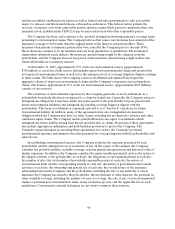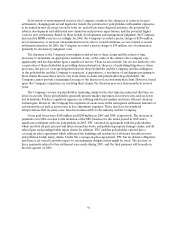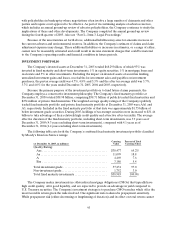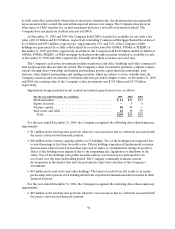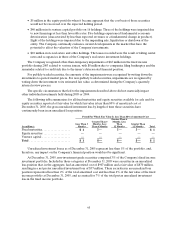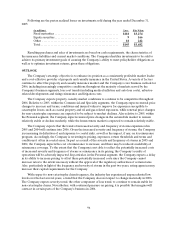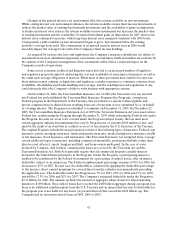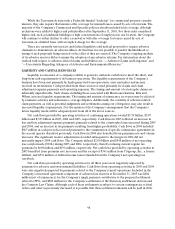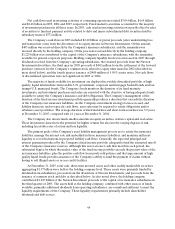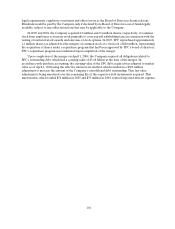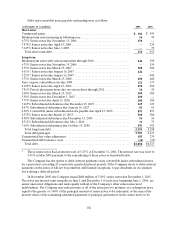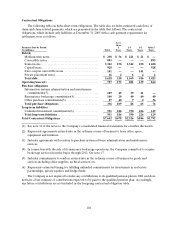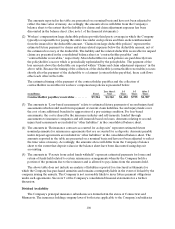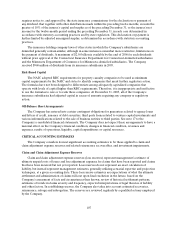Travelers 2005 Annual Report Download - page 109
Download and view the complete annual report
Please find page 109 of the 2005 Travelers annual report below. You can navigate through the pages in the report by either clicking on the pages listed below, or by using the keyword search tool below to find specific information within the annual report.97
Changes in the general interest rate environment affect the returns available on new investments.
While a rising interest rate environment enhances the returns available on new fixed income investments, it
reduces the market value of existingfixed maturity investments and the availability of gains on disposition.
A decline in interest rates reduces the returns available on new investments but increases the market value
of existing investments and the availability of realized investment gains on disposition. In 2005, short-term
interest rates continued to increase, while long-term interest rates remained consistent with 2004 levels.
Consequently, yields available on new investments began to grow, but remained below the existing
portfolio’s average book yield. The continuation of anupward trend in interest rates in2006 would
favorably impact the average book yield of the Company’s fixed income holdings.
As required by various state laws and regulations, the Company’s insurance subsidiaries are subject to
assessments from state-administered guaranty associations, second-injury funds and similar associations. In
the opinion of the Company’s management, these assessments will not have a material impact on the
Company’s results of operations.
Some social, economic, political and litigation issues have led to an increased number of legislative
and regulatory proposals aimed at addressing the cost and availability of some types of insurance as well as
the claim and coverage obligations of insurers. While most of these provisions have failed to become law,
these initiatives may continue as legislators and regulators consider responses to consumer concerns about
availability, affordability and claims handling and coverage, and the resulting laws and regulations, if any,
could adversely affect the Company’s ability to write business with appropriate returns.
On November 26, 2002, the Terrorism Risk Insurance Act of 2002 (the Terrorism Act) was enacted
into Federal law and established the Terrorism Risk Insurance Program (the Program), a temporary
Federal program in the Department of the Treasury, that provided fora system of shared public and
private compensation for insured losses resulting from acts of terrorism or war committed by or on behalf
of a foreign interest. The Program was scheduled to terminate on December 31, 2005. On December 22,
2005, the Terrorism Risk Insurance Extension Act of 2005 (theTerrorism Extension Act) was enacted into
Federal law, reauthorizing the Program through December 31, 2007, while reducing the Federal role under
the Program. In order for a loss to be covered under the Program (subject losses), the loss must meet
certain aggregate industry loss minimums that vary by Program year of amounts $100 million or less, and
must be the result of an event that is certified as an act of terrorism by the U.S. Secretary of the Treasury.
The original Program excluded from participation certain of the following types of insurance: Federal crop
insurance, private mortgage insurance, financial guaranty insurance, medical malpractice insurance, health
or life insurance, flood insurance, and reinsurance. The Terrorism Extension Act exempted from coverage
certain additional types of insurance, including commercial automobile, professional liability (other than
directors and officers’), surety, burglary and theft, and farm-owners multi-peril. In the case of a war
declared by Congress, only workers’ compensation losses are covered by the Terrorism Act and the
Terrorism Extension Act. Both Acts generally require that all commercial property casualty insurers
licensed in the United States participate in the Program.Under the Program, a participating insurer is
entitled to be reimbursed by the Federal Government for a percentage of subject losses, after an insurer
deductible, subject to an annual cap. The Federal reimbursement percentage remains at 90% for 2006, but
decreases to 85% in 2007. In each case, the deductible is calculated by applying the deductible percentage
to the insurer’s direct earned premiums for covered lines from the calendar year immediately preceding
the applicable year. The deductible under the Program was 7% for 2003, 10% for 2004 and 15% for 2005,
and will be 17.5% for 2006 and 20% for 2007. The Company’s estimated deductible under the Program is
$1.91 billion for 2006. The annual cap limits the amountof aggregate subject losses for all participating
insurers to $100 billion. Once subject losses have reached the $100 billion aggregate during a program year,
there is no additional reimbursement from the U.S. Treasury and an insurer that has met its deductible for
the program year is not liable for any losses (or portion thereof) that exceed the $100 billion cap. The
Company had no terrorism-related losses in 2005, 2004 or 2003.





